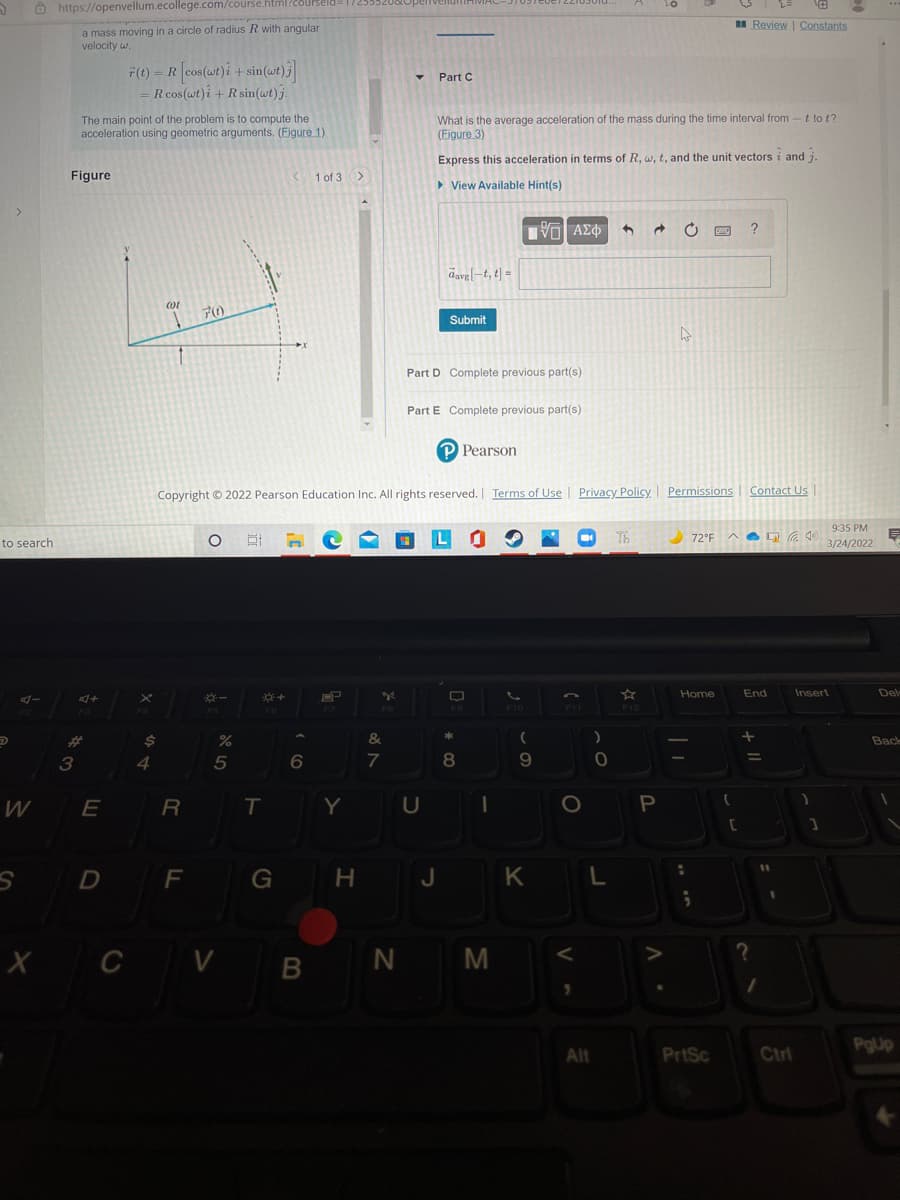Review | Constants a mass moving in a circle of radius R with angular velocity w. =R cos(ust)i + sin(wt)} R cos(wt)i + R sin(wt)j. Part C The main point of the problem is to compute the acceleration using geometric arguments. (Figure 1) What is the average acceleration of the mass during the time interval from -t to t? (Eigure 3) Express this acceleration in terms of R, w, t, and the unit vectors i and j. Figure 1 of 3> > View Available Hint(s) davel-t, t) = Cot Submit
Review | Constants a mass moving in a circle of radius R with angular velocity w. =R cos(ust)i + sin(wt)} R cos(wt)i + R sin(wt)j. Part C The main point of the problem is to compute the acceleration using geometric arguments. (Figure 1) What is the average acceleration of the mass during the time interval from -t to t? (Eigure 3) Express this acceleration in terms of R, w, t, and the unit vectors i and j. Figure 1 of 3> > View Available Hint(s) davel-t, t) = Cot Submit
Principles of Physics: A Calculus-Based Text
5th Edition
ISBN:9781133104261
Author:Raymond A. Serway, John W. Jewett
Publisher:Raymond A. Serway, John W. Jewett
Chapter11: Gravity, Planetary Orbits, And The Hydrogen Atom
Section: Chapter Questions
Problem 65P
Related questions
Topic Video
Question

Transcribed Image Text:O https://openvellum.ecollege.com/course.html
Review | Constants
a mass moving in a circle of radius R with angular
velocity w.
F(t) = R cos(wt)i + sin(wt)j
= R cos(wt)i +R sin(wt) j.
Part C
The main point of the problem is to compute the
acceleration using geometric arguments. (Figure 1)
What is the average acceleration of the mass during the time interval from -t to t?
(Eigure 3)
Express this acceleration in terms of R, w, t, and the unit vectors i and j
Figure
1 of 3>
> View Available Hint(s)
?
davg-t, t| =
70
Submit
Part D Complete previous part(s)
Part E Complete previous part(s)
P Pearson
Copyright © 2022 Pearson Education Inc. All rights reserved. Terms of Use | Privacy Policy I Permissions
Contact Us
9:35 PM
L O
Th
72°F
to search
3/24/2022
Home
End
Insert
Del
F8
F9
F10
F11
F12
F3
F5
%23
&
Bace
3
4
5
7
W
R
T
Y
D F G H J KL
X C V B
N M
PgUp
Alt
PrtSc
Ctrl
Expert Solution
This question has been solved!
Explore an expertly crafted, step-by-step solution for a thorough understanding of key concepts.
Step by step
Solved in 3 steps

Knowledge Booster
Learn more about
Need a deep-dive on the concept behind this application? Look no further. Learn more about this topic, physics and related others by exploring similar questions and additional content below.Recommended textbooks for you

Principles of Physics: A Calculus-Based Text
Physics
ISBN:
9781133104261
Author:
Raymond A. Serway, John W. Jewett
Publisher:
Cengage Learning

Classical Dynamics of Particles and Systems
Physics
ISBN:
9780534408961
Author:
Stephen T. Thornton, Jerry B. Marion
Publisher:
Cengage Learning

University Physics Volume 1
Physics
ISBN:
9781938168277
Author:
William Moebs, Samuel J. Ling, Jeff Sanny
Publisher:
OpenStax - Rice University

Principles of Physics: A Calculus-Based Text
Physics
ISBN:
9781133104261
Author:
Raymond A. Serway, John W. Jewett
Publisher:
Cengage Learning

Classical Dynamics of Particles and Systems
Physics
ISBN:
9780534408961
Author:
Stephen T. Thornton, Jerry B. Marion
Publisher:
Cengage Learning

University Physics Volume 1
Physics
ISBN:
9781938168277
Author:
William Moebs, Samuel J. Ling, Jeff Sanny
Publisher:
OpenStax - Rice University

Physics for Scientists and Engineers: Foundations…
Physics
ISBN:
9781133939146
Author:
Katz, Debora M.
Publisher:
Cengage Learning

College Physics
Physics
ISBN:
9781938168000
Author:
Paul Peter Urone, Roger Hinrichs
Publisher:
OpenStax College

University Physics Volume 3
Physics
ISBN:
9781938168185
Author:
William Moebs, Jeff Sanny
Publisher:
OpenStax